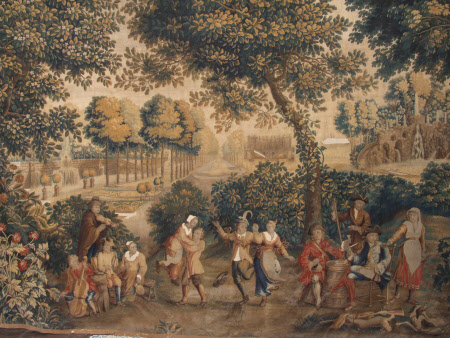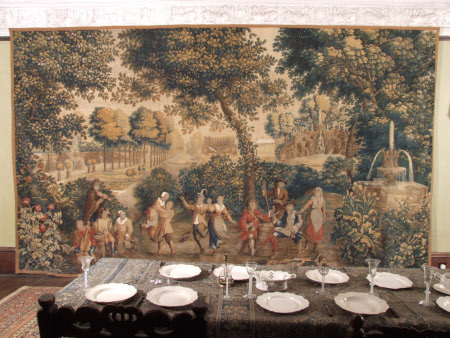Peasants Dancing
probably Lille
Category
Tapestries
Date
circa 1700 - circa 1730
Materials
Tapestry, wool and silk, 6 warps per cm
Measurements
2.88 m (H); 4.92 m (W)
Place of origin
Lille
Order this imageCollection
Chastleton House, Oxfordshire
NT 1430618
Summary
Tapestry, wool and silk, 6 warps per cm, Peasants Dancing, probably Willem Werniers, Lille, c. 1700-1730. In the centre a group of four peasants dance to the music of a band that plays on the left hand side, made up of a cellist, a fiddler standing on a stool and a man playing a triangle. A peasant woman holding a pitcher sits on a bench watching the dancers. On the right a group of huntsmen drink and smoke around a barrel which they use as a table. A dead hare and a rifle lie on the ground beside them and their dog sits nearby scratching his chin with his paw. A maid offers the huntsmen a drink, suggesting that the scene takes place outside an inn. In the background there is a formal garden with fountains. The tapestry has no borders and may have been woven without them, but a narrow brown edging has been applied around all four sides.
Full description
The tapestry belongs to a genre known as 'Teniers' tapestries, because their designs of peasants making merry are in the style of the artist David II Teniers (1610-1690), even though they were not all designed by him. The huge popularity of so-called 'Teniers' tapestries was one of the most striking trends in eighteenth-century European tapestry production. The genre originated in Brussels in the last decades of the seventeenth century, and gained in popularity so rapidly that by the early eighteenth century Teniers tapestries were being exported throughout Europe. Teniers's paintings of peasant scenes were notable for their positive portrayal of his subjects, which contrasted with earlier Dutch and Flemish artists who had tended to represent the peasants in a satirical light. While many of the 'Teniers' tapestries include comic elements, such as the man lifting his companion off her feet as they dance in the Chastleton tapestry, the men and women are presented as essentially honest and rustic rather than dangerously unruly. It is this simple, almost Arcadian vision of rural life that holds the key to the success of the 'Teniers' tapestries. 'Teniers' tapestries were produced not just in Brussels but in other Flemish weaving centres including Antwerp and Oudenaarde, and also further afield, including the French towns of Lille and Aubusson, and even workshops in London and Madrid. The tapestry at Chastleton was probably made at the workshop of Willem Werniers in Lille, a town which had been part of the Netherlands until 1667 when it was captured by the French. Lille was not traditionally a great tapestry-producing town but in the late seventeenth and eighteenth centuries a number of Flemish weavers emigrated there. Werniers was the son-in-law of a Brussels weaver named Jan de Melter who emigrated to Lille in 1689. Werniers himself was registered as a citizen of Lille in 1701 and by 1733 had a workshop including 21 looms. When he died in 1738 this was taken over by his widow, who carried the workshop on until she died in 1778 (Delmarcel 1999, p. 339; Forti-Grazzini 1994, pp. 356-70). The tapestry at Chastleton probably dates from c. 1700-1730. A tapestry sold in Paris in 1919 included the same group of resting huntsmen that appears at the right hand end of the Chastleton tapestry (Marillier Tapestry Subject Index). The border of the Paris tapestry is of a type found on other Teniers tapestries bearing the signature of Willem Werniers. The early history of the tapestry is unknown, but it may have been acquired for Chastleton by John Henry Whitmore-Jones (1795/6-1853), who made some changes to the house and who recorded buying tapestries in his diary (Cooper 1997, p. 15). (Helen Wyld, 2012)
Provenance
Possibly acquired for Chastleton by John Henry Whitmore-Jones (1795/6-1853); thence by descent and bequest to Allan Clutton-Brock (1904-1976) and his wife Barbara Foy; acquired by The National Heritage Memorial Fund and transferred to The National Trust in 1991.
Credit line
Chastleton House, The Whitmore-Jones Collection (acquired by The National Heritage Memorial Fund and transferred to The National Trust in 1991)
Makers and roles
probably Lille , workshop probably Willem Werniers (d. Lille 1738), workshop style of David Teniers the younger (Antwerp 1610 - Brussels 1690), designer
References
Delmarcel, 1999: Guy Delmarcel, Flemish Tapestry, Tielt 1999 Nicholas Cooper, Chastleton House, London (National Trust) 1997 Forti-Grazzini, 1994: Nello Forti-Grazzini, Gli Arazzi (Il patrimonio artistico del Quirinale), 2 vols., Rome 1994

